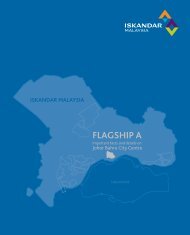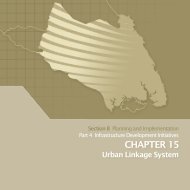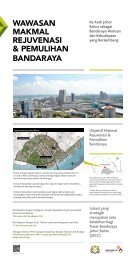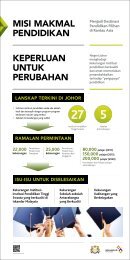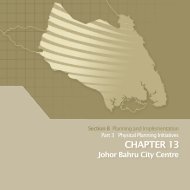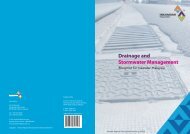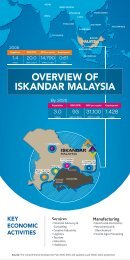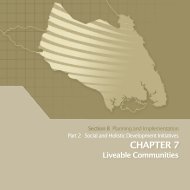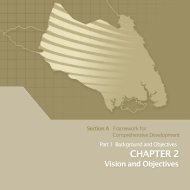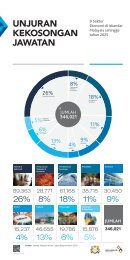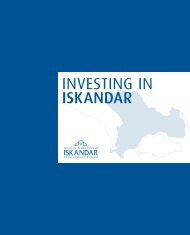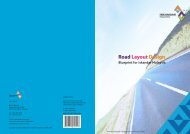Social Development Strategies - Iskandar Malaysia
Social Development Strategies - Iskandar Malaysia
Social Development Strategies - Iskandar Malaysia
Create successful ePaper yourself
Turn your PDF publications into a flip-book with our unique Google optimized e-Paper software.
Section A Framework for<br />
Comprehensive <strong>Development</strong><br />
Part 2 <strong>Development</strong> <strong>Strategies</strong><br />
CHAPTER 5<br />
<strong>Social</strong> <strong>Development</strong> <strong>Strategies</strong>
<strong>Social</strong> <strong>Development</strong> <strong>Strategies</strong><br />
chapter<br />
5<br />
5.1 Introduction<br />
This section deals with three socio-economic aspects; poverty, wealth<br />
distribution and the issues relating to the Bumiputera Commercial and<br />
Industrial Community (BCIC).<br />
5.2 Poverty<br />
About 93% of SJER population of 1.35 million live in urban areas. The<br />
rest numbering about 100,000 live in rural areas consisting mainly of<br />
traditional Malay kampungs, Felda schemes, new villages, Orang Asli<br />
settlements and estates. For Johor state, the Poverty Line Income (PLI)<br />
is set at RM634. For hardcore poverty, it is set at RM384 (Ninth <strong>Malaysia</strong><br />
Plan).<br />
The overall poverty rate for Johor state was 2.0% in 2004 (the Ninth<br />
<strong>Malaysia</strong> Plan). The overall poverty rate for SJER is estimated at 0.42%.<br />
■ Urban Poverty<br />
For Johor, the level was at 0.8% in 2002 (<strong>Malaysia</strong>n Quality of Life<br />
Report). This was well below the <strong>Malaysia</strong>n average at 2.0%. For<br />
SJER, the urban poverty rate is estimated at less than 0.1%. This is<br />
very low considering that the majority, 92.6% of SJER population<br />
are urban population.<br />
Based on the proportion of Felda households which is about 15.0%<br />
of the rural population and the proportion of kampung households<br />
which represent most of the remaining 85.0%, the overall weighted<br />
rural poverty rate for SJER is estimated at 4.7%. The rate is still very<br />
much lower than the <strong>Malaysia</strong>n average of 11.9% for rural poverty.<br />
■ Hardcore Poor<br />
The hardcore poverty rates for Johor state and <strong>Malaysia</strong> were<br />
0.3% and 2.9% respectively in 2004 and (the Ninth <strong>Malaysia</strong> Plan).<br />
Based on the listings by the Johor Bahru and Pontian district<br />
offices, there is a total of 138 households receiving assistance as<br />
at January 2006 under the Skim Pembangunan Kesejahteraan<br />
Rakyat (SPKR) in SJER of which 100 households are in Johor Bahru<br />
district and 38 households in the three mukims of Serkat, Sungai<br />
Karang and Jeram Batu.<br />
Of these, 117 households earn a gross monthly household<br />
income of less than RM384 which are regarded as hardcore poor<br />
households. Therefore, the hardcore poverty rate in SJER is at less<br />
than 0.1% which is much lower than for Johor and <strong>Malaysia</strong>.<br />
Based on the above, it is clear that absolute poverty is not a major<br />
problem in SJER.<br />
■ The Less Fortunate<br />
■ Rural Poverty<br />
The rural population in SJER is estimated to be around 100,000<br />
people or 7.4% of the total SJER population. From the Rural<br />
Household Survey done, it was found that the rural poverty rate<br />
for SJER is at 5.6% for traditional kampungs and 1.4% for Felda<br />
schemes.<br />
The Less Fortunate mainly refers to the disabled, the orphans,<br />
the elderly and single mothers. At present, SJER has the highest<br />
number and proportion of the Less Fortunate in the state. It has<br />
9,223 representing 28.9% of the state’s total in 2005. In SJER, the<br />
majority, about 65.0% are the disabled and 16.0% are orphans.<br />
5 - 1
SECTION A<br />
FRAMEWORK FOR COMPREHENSIVE DEVELOPMENT<br />
■ The Orang Asli Communities<br />
There are ten Orang Asli settlements in SJER, nine in Johor Bahru<br />
district and one in the mukim of Serkat with a total population of<br />
around 1,405 persons.<br />
Almost half of the Orang Asli households in Johor Bahru district are<br />
hardcore poor. In Pontian district, only about 10% of the Orang Asli<br />
households are hardcore poor.<br />
■ Profile of the Rural Poor Households in SJER<br />
Based on the Field Survey Report for the Rural Household Survey<br />
(Economic and <strong>Social</strong> Aspect, 2006), some major characteristics<br />
of the rural poor households in and around SJER are:<br />
□ The majority, 96% of the rural poor households are Bumiputeras.<br />
□ The average household size of the poor households is 4.8 which<br />
is smaller than that of the non-poor households at 5.2<br />
□ About 42% of the members of the poor households are of five<br />
to 19 years old suggesting that these households comprise of<br />
mainly young families.<br />
□ The proportion of the elderly (above 64 years old) is higher<br />
in the rural poor households at 9.5% than in non-poor rural<br />
households at 3% only<br />
□ About 84.2% of the heads of the poor households are married.<br />
The rest, 15.8% are widows and widowers. For the non-poor<br />
kampong households, only 8% are widows and widowers.<br />
□ About 28.4% of the members of the poor households have no<br />
formal education as compared with 5.1% for the non-poor<br />
households.<br />
□ Most working members of the rural poor households work as<br />
fishermen and farmers (66.7%) and sales workers (20%). In nonpoor<br />
rural households, the corresponding figures are 4.7% and<br />
13.4%.<br />
□ About 95% of the poor households are supported by single<br />
working members as compared with two working members in<br />
non-poor rural households.<br />
□ The majority, 84.2% of the rural poor households are landless. In<br />
non-poor rural households, only 67.9% are landless.<br />
□ The unemployment rate (percentage of total work force)<br />
for the rural poor households is higher at 22.7% than in nonpoor<br />
households at about 4.8% only. The overall average<br />
unemployment rate is 5.4%.<br />
□ The majority, 80% of the heads of the rural poor households<br />
stated that they are interested to participate in the relocation<br />
programmes which include a package of land, home and<br />
jobs.<br />
□ A high percentage, 93.3% of them also stated that they are<br />
interested in participating in economic projects at the present<br />
site.<br />
□ About 66.7% of the heads of the rural poor households stated<br />
that they would permit their children to stay at hostels nearby<br />
while another 13.3% would not allow. The rest, 20%, are not<br />
sure.<br />
5.3 Ethnic Difference In Property Ownership<br />
A. Property Ownership<br />
About 15.7% of the whole assessed properties (in terms of number) in<br />
MBJB, MPJBT, MP Kulai and part of MD Pontian (MDP) are owned by<br />
the Bumiputera; 35.5% by the Chinese; 3.6% by the Indians; 13.6% by<br />
developers and the remaining 31.7% by other business entities and<br />
institutions and others. The data for Pasir Gudang is not available. The<br />
Bumiputeras own 28.6% of the total assessed properties in MBJB; 11.9% in<br />
MPJBT; 7.1% in MP Kulai and 11.7% in part of MDP.<br />
B. Property Value<br />
The total value of the assessed properties in the four areas stands<br />
at RM66.65 billion. Of this total, RM33.67 billion or 50.5% are in MBJB,<br />
RM23.47 billion or 35.2% are in MPJBT, RM9.09 billion or 13.6% are in MP<br />
Kulai and RM0.42 billion or 0.6% are in MD Pontian.<br />
5 - 2
SOCIAL DEVELOPMENT STRATEGIES CHAPTER 5 | PART 2<br />
Figure 5.1: Total Value of Assessed Properties by Local<br />
Authority and Racial Groups in SJER, 2006<br />
Within the four areas together, the Bumiputeras own a total of RM7.43<br />
billion or 11.2% of the total property value that are assessed. The<br />
Chinese hold a much larger share at RM20.32 billion or 30.5%. The<br />
16,000.0<br />
MBJB<br />
14,810.7<br />
Indians hold RM1.98 billion or 3.0%; companies hold RM29.04 billion<br />
RM (Million)<br />
14,000.0<br />
12,000.0<br />
10,000.0<br />
8,000.0<br />
6,000.0<br />
4,000.0<br />
4,364.3<br />
12,567.1<br />
or 43.6%; developers hold RM6.66 billion or 10.0% and others hold the<br />
remaining RM1.23 billion or 1.8% (Figure 5.1).<br />
C. Property Value Per Head<br />
2,000.0<br />
834.0 1,090.4<br />
0.6<br />
Malay Chinese Indian Others Other<br />
Business<br />
Entities &<br />
Institutions<br />
Developer<br />
In terms of property value per head of population by race, the total<br />
property value per head for the Bumiputeras is the lowest at RM18,684<br />
as compared with that of the Chinese (RM59,527), the Indians<br />
Ethnicity/Group<br />
(RM24,246) and the Others (RM23,087). This shows that the value per<br />
9,000.0<br />
8,000.0<br />
7,000.0<br />
MPJBT<br />
7,695.1<br />
6,570.4<br />
capita for the Chinese is more than three times larger than that of the<br />
Bumiputeras (Figure 5.2).<br />
RM (Million)<br />
6,000.0<br />
5,000.0<br />
4,000.0<br />
3,000.0<br />
2,000.0<br />
1,000.0<br />
2,690.2<br />
5,383.6<br />
1,005.2<br />
127.6<br />
It is the expressed policy of the Government (refer the Ninth <strong>Malaysia</strong><br />
Plan) to narrow this gap between the Malay property ownership and<br />
that of the non-Malays.<br />
250.0<br />
200.0<br />
Malay Chinese Indian Others Other<br />
Business<br />
Entities &<br />
Institutions<br />
Developer<br />
205.8<br />
Ethnicity/Group<br />
MDP<br />
Figure 5.2: Property Value Per Head (in RM) of Various Racial<br />
Groups in SJER, 2006<br />
RM (Million)<br />
150.0<br />
100.0<br />
2,690.2<br />
93.9 87.9<br />
70,000<br />
60,000<br />
59,527<br />
50.0<br />
1.1<br />
Malay Chinese Indian Others Other<br />
Business<br />
Entities &<br />
Institutions<br />
Developer<br />
MPKu<br />
2.8<br />
RM (Million)<br />
50,000<br />
40,000<br />
30,000<br />
20,000<br />
18,684<br />
24,246 23,067<br />
7,000.0<br />
6,000.0<br />
Ethnicity/Group<br />
6,48.3<br />
10,000<br />
RM (Million)<br />
5,000.0<br />
4,000.0<br />
3,000.0<br />
2,159.4<br />
Malay Chinese Indian Others<br />
2,000.0<br />
1,000.0<br />
350.2<br />
135.0<br />
5.7<br />
-<br />
Source: SJER CDP 2025<br />
Malay Chinese Indian Others Other<br />
Business<br />
Entities &<br />
Institutions<br />
Developer<br />
Source: SJER CDP 2025<br />
Ethnicity/Group<br />
5 - 3
SECTION A<br />
FRAMEWORK FOR COMPREHENSIVE DEVELOPMENT<br />
5.4 Bumiputera Participation In Commerce And Industry<br />
The Bumiputera participation in commerce and industries in SJER is still<br />
low.<br />
A. In Commerce<br />
Based on data collected by the Johor Bahru District Local Plan Study,<br />
of the total 27,910 commercial establishments in the whole Johor Bahru<br />
district in 2003, only 4,695 establishments or 16.8% of them were Malay<br />
owned. The Chinese proportion was far higher at 21,514 establishments<br />
or 77.1% whilst the Indian proportion was 884 establishments or 3.2%.<br />
Table 5.1: Equity Ownership of Industries in SJER, 2006 (weighted<br />
averages in percentage)<br />
Ownership E&E Logistics SMEs Chemical<br />
(Plastic)<br />
Food<br />
Bumiputera 10.86 29.80 11.57 5.80 17.35<br />
Non-<br />
Bumiputera<br />
Government/<br />
Public<br />
Institution<br />
27.28 47.48 45.16 76.00 49.18<br />
1.06 2.66 0.72 0.00 2.42<br />
State Owned 0.00 0.00 10.70 0.00 0.00<br />
Foreign 60.80 20.06 31.85 18.20 31.05<br />
Total 100.00 100.00 100.00 100.00 100.00<br />
B. In Industry<br />
Source: Industrial Surveys, 2006 for the SJER <strong>Development</strong> Master Plan Study<br />
The Bumiputera industrial establishments in Johor Bahru district in 2003<br />
was also low, totalling 799 establishments or 12.0% of a total of 6,642<br />
Figure 5.3: Percentage Distribution of Bumiputera SMEs by<br />
Industry Types in Johor State, 2006<br />
establishments. The Chinese and Indian shares were higher at 64.1% and<br />
19.3% respectively.<br />
18<br />
16<br />
15.04<br />
16.17<br />
The Bumiputera participation is mainly in SMEs. Of the total 1,102 SMEs<br />
in the whole state of Johor which are registered with Small and Medium<br />
Industries <strong>Development</strong> Corporation (SMIDEC), 24.2% are owned by<br />
Bumiputeras. In terms of capitalised value, the proportion is lower. The<br />
SME Survey (limited to manufacturing) indicates that the Bumiputera’s<br />
overall share is only about 11.6%. These SMEs are largely concentrated<br />
in Johor Bahru district and are largely involved in services, food and<br />
drinks and wood and wood-based industries (Table 5.1 and Figure 5.3).<br />
Percentage (%)<br />
14<br />
12<br />
10<br />
8<br />
6<br />
4<br />
2<br />
0<br />
0 0.38<br />
Rubber<br />
Oil Palm<br />
0.75<br />
Non-Metallic<br />
2.63 2.63 2.63<br />
Metallic<br />
Textile and<br />
Clothing<br />
Logistics<br />
3.76<br />
Transport<br />
Equipment<br />
4.51<br />
Pharmaceutical<br />
4.89<br />
Printing and<br />
Paper Products<br />
5.26<br />
Chemical and<br />
Petrochemical<br />
6.77<br />
Plastic<br />
9.4<br />
Electrical and<br />
Electronic<br />
12.03<br />
Machinery and<br />
Engineering<br />
13.16<br />
Wood and<br />
Based<br />
Food and<br />
Drinks<br />
Services<br />
Industry Type<br />
Of the total number of business licences issued by MBJB and MPJBT<br />
numbering 35,955, the Bumiputeras represent 19.4% of the total. In<br />
contrast, the Chinese represent 72.0% and the Indians 4.3%. However, it<br />
is not known how many of the Bumiputera licensees are active.<br />
The Industrial Surveys (excluding the very large companies) also<br />
revealed that Bumiputera’s equity in specific industries is still low. Their<br />
shares (weighted) are 10.9% in the E&E industries, 5.8% in the chemical<br />
industries, 17.4% in food industries, 11.6% in SMEs and 29.8% in the<br />
logistics services (see Table 5.1, Figure 5.3).<br />
Source: Industrial Surveys, 2006 for the SJER <strong>Development</strong> Master Plan Study<br />
The proportion of Bumiputeras holding top positions (as managers,<br />
engineers, other professionals, technicians, supervisors and clerical<br />
officers) in all the industries is lower as compared to that of the non-<br />
Bumiputeras.<br />
5 - 4
SOCIAL DEVELOPMENT STRATEGIES CHAPTER 5 | PART 2<br />
Among the Bumiputeras that work in the electrical and electronics<br />
industries, 24.9% only are holding the top posts as compared to 53.7% for<br />
the non-Bumiputeras. In other industries, the proportions of Bumiputera<br />
holding the top positions are also low (40.3% in logistics, 65% in chemical,<br />
56.6% in food and 29.3% in SMEs). In contrast, the proportions for the<br />
non-Bumiputeras are higher (44.8% in logistics, 70.9% in plastic, 61.0% in<br />
food and 46.5% in SMEs) (Table 5.2 and Figures 5.3 and 5.4 ).<br />
Percentage (%)<br />
Figure 5.4: Equity of Industries in SJER, 2006 (weighted averages<br />
in percentage)<br />
80.00<br />
70.00<br />
60.00<br />
50.00<br />
40.00<br />
30.00<br />
20.00<br />
10.00<br />
0.00<br />
27.28<br />
10.8<br />
1.06<br />
60.80<br />
29.80<br />
47.48<br />
2.66<br />
20.06<br />
11.57<br />
45.16<br />
0.72<br />
31.85<br />
76.00<br />
0.00<br />
E&E Logistics SMEs Chemical<br />
Ownership<br />
(Plastic)<br />
18.20 17.35<br />
49.18<br />
2.42<br />
Food<br />
31.05<br />
Bumiputera Non-Bumiputera Government/Public Institution State Owned Foreign<br />
Source: Industrial Surveys, 2006 for the SJER <strong>Development</strong> Master Plan Study<br />
Table 5.2: Occupational Categories of Various Racial Groups by Major Selected Industry Types in SJER, 2006<br />
Designation<br />
Managers<br />
Engineers<br />
Other<br />
professionals<br />
Technicians<br />
Supervisor and<br />
Clerical<br />
Officers<br />
Skilled workers<br />
Semi skilled<br />
workers<br />
Unskilled<br />
workers<br />
<strong>Malaysia</strong>n<br />
ELECTRICAL & ELECTRONIC LOGISTICS SMEs<br />
Foreigners<br />
Total<br />
Row%<br />
<strong>Malaysia</strong>n<br />
Non-<br />
Bumiputera<br />
Foreigners<br />
Total<br />
Row%<br />
<strong>Malaysia</strong>n<br />
Bumiputera<br />
Non-<br />
Bumiputera<br />
Bumiputera<br />
Bumiputera<br />
Non-<br />
Bumiputera<br />
Foreigners<br />
Row % 11.76 75.00 13.24 100.00 38.50 60.00 1.5 100.00 14.90 72.30 100.00<br />
Column % 0.73 12.76 0.87 3.03 13.54 100.0 1.77 12.36 2.50<br />
Row % 28.85 66.83 4.33 100.00 0.00 100.00 - 100.00 49.70 47,40 3.90 100.00<br />
Column % 1.83 11.59 0.29 - 6.25 - 3.05 4.27 0.40<br />
Row % 31.49 66.38 2.13 100.00 81.80 18.20 - 100.00 54.10 46.00 100.00<br />
Column % 2.26 13.01 0.16 6.55 4.17 - 1.61 1.96<br />
Row % 76.49 15.88 7.63 100.00 92.90 7.10 - 100.00 61.80 24.30 13.80 100.00<br />
Column % 11.35 6.42 1.20 3.15 0.69 - 7.55 4.27 2.70<br />
Row % 70.44 29.31 0.25 100.00 79.60 20.40 - 100.00 48.10 51.60 0.30 100.00<br />
Column % 8.75 9.92 0.03 27.52 20.14 - 15.34 23.67 0.10<br />
Row % 39.38 6.48 54.15 100.00 81.40 18.60 - 100.00 39.30 20.90 30.80 100.00<br />
Column % 45.75 20.52 66.63 10.06 6.60 - 20.56 15.70 33.60<br />
Row % 71.06 10.60 18.34 100.00 60.00 40.0 - 100.00 36.10 34.80 29.10 100.00<br />
Column % 15.99 6.51 4.37 15.64 29.86 - 17.03 23.56 22.20<br />
Row % 37.07 4.08 58.85 100.00 71.90 28.10 - 100.00 79.10 16.7 4.30 100.00<br />
Column % 8.90 2.67 14.97 4.97 5.56 - 16.39 4.97 1.40<br />
Total<br />
Row%<br />
General<br />
Workers<br />
Row% 20.77 28.51 50.72 100.00 86.30 13.70 - 100.00 36.20 13.90 49.80 100.00<br />
Column % 4.43 16.60 11.47 29.09 13.19 - 16.70 9.24 37.10<br />
Total Column % 100.00 100.00 100.00 100.00 100.00 100.00 100.00 100.00 100.00<br />
Source : Industrial Surveys, 2006 for the SJER <strong>Development</strong> Master Plan Study<br />
5 - 5
SECTION A<br />
FRAMEWORK FOR COMPREHENSIVE DEVELOPMENT<br />
Table 5.2 (continued): Occupational Categories of Various Racial Groups by Major Selected Industry Types in SJER, 2006<br />
Designation<br />
Managers<br />
Engineers<br />
Other<br />
professionals<br />
Technicians<br />
Supervisor and<br />
Clerical<br />
Officers<br />
Skilled workers<br />
Semi skilled<br />
workers<br />
Unskilled<br />
workers<br />
General<br />
Workers<br />
<strong>Malaysia</strong>n<br />
FOOD<br />
Foreigners<br />
Total<br />
Row%<br />
Bumiputera<br />
Non-<br />
Bumiputera<br />
Bumiputera<br />
<strong>Malaysia</strong>n<br />
Non-<br />
Bumiputera<br />
CHEMICAL<br />
Foreigners<br />
Total<br />
Row%<br />
Row % 44.4 50.00 5.60 100.00 5.56 88.89 5.56 100.00<br />
Column % 15.1 22.00 16.70 2.50 29.09 6.25<br />
Row % 50.0 50.00 0.00 100.00 63.64 27.27 9.09 100.00<br />
Column % 1.90 2.40 0.00 17.50 5.45 6.25<br />
Row % 50.0 50.00 0.00 100.00 16.67 83.33 - 100.00<br />
Column % 7.50 9.80 0.00 2.50 9.09 -<br />
Row % 66.70 33.30 0.00 100.00 61.54 38.46 - 100.00<br />
Column % 11.30 7.30 0.00 20.00 9.09 -<br />
Row % 57.90 42.10 0.00 100.00 45.00 50.00 5.00 100.00<br />
Column % 20.80 19.50 0.00 22.50 18.18 6.25<br />
Row % 61.50 38.50 0.00 100.00 27.78 50.00 22.22 100.00<br />
Column % 15.10 12.20 0.00 12.50 16.36 25.00<br />
Row % 70.00 30.00 0.00 100.00 57.14 28.57 14.29 100.00<br />
Column % 13.20 7.30 0.00 10.00 3.64 6.25<br />
Row % 20.00 40.00 40.00 100.00 50.00 12.50 37.50 100.00<br />
Column % 1.90 4.90 33.30 10.00 1.82 18.75<br />
Row% 43.80 37.50 18.70 100.00 10.00 40.00 50.00 100.00<br />
Column % 13.20 14.60 50.0 2.5 7.23 31.25<br />
Source : Industrial Surveys,<br />
2006 for the SJER<br />
<strong>Development</strong><br />
Master Plan Study<br />
Total Column % 100.00 100.00 100.00 100.00 100.00 100.00<br />
5.5 The Major Strategic <strong>Social</strong> <strong>Development</strong> Thrusts<br />
The following Strategic <strong>Social</strong> <strong>Development</strong> Thrusts (SSDT) are proposed.<br />
Various initiatives under these thrusts are detailed out in Section B, Part<br />
2, Chapter 8, <strong>Social</strong> <strong>Development</strong> Initiatives of the CDP.<br />
SSDT 1: Enhance coordination and cohesion of all government and<br />
non-government agencies involved in social development<br />
SSDT 2: Build social capital as the basis for social cohesion and<br />
intergration<br />
SSDT 4: Adopt and implement a regional and physical development<br />
strategies that will result in the increase in the value of Bumiputera land<br />
and also bring other benefits.<br />
SSDT 5: Promote more mutual funds to spread benefit of the increase in<br />
property and rental values to Bumiputera and to take out the allocated<br />
new property units not taken up by Bumiputeras.<br />
SSDT 6: Enhance and upgrade education and training programme<br />
at all level of skills and with the cluster associations identify critical skill<br />
categories for SJER development.<br />
SSDT 3: Enhance ability of individual Bumiputera and privately owned<br />
Bumiputera companies especially SMEs to acquire landed properties<br />
and enhance their property portfolio by leveraging and participating in<br />
the capital gain.<br />
SSDT 7: Enhance cluster linkages among major public and private sector<br />
corporations and research institutions with Bumiputera companies<br />
especially SMEs.<br />
5 - 6



